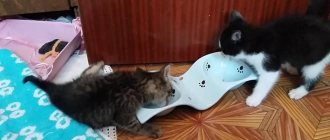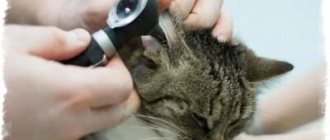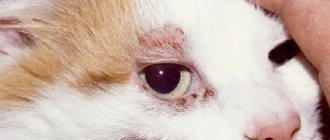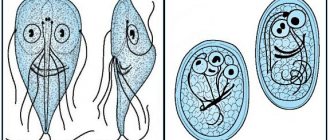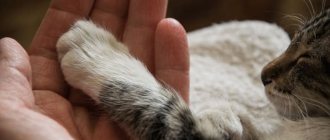Ataxia is a violation of coordination and voluntary movements. The cause of this condition is damage to the motor neurons of the brain, due to which the animal has a gait disorder, tremors of the limbs, or weak muscle tone.
With this diagnosis, kittens are often born from a mother who has leukopenia. If the pathology is acquired and appears at an older age, it could be triggered by traumatic brain injury, meningitis or oncology. Some doctors do not exclude the role of burdened heredity in the development of the disease. Laboratory and instrumental diagnostics, which are carried out in our clinic, will help determine the exact cause.
FAQ
Is ataxia painful in cats?
If cerebellar ataxia is caused by feline distemper virus, cats can have a good life expectancy, especially with support and exposure to the disease at home. This is not a painful condition for cats.
What causes ataxia in cats?
Cats with ataxia may wobble, have difficulty hearing, and appear sleepy. Possible causes include neurological problems, cancer, injury, viral or fungal infection. An infection of the inner ear can also cause ataxia.
Causes
A common cause of peripheral vestibular disorders is otitis media or inner ear. Bacterial infections can cause disease in the external auditory canal or upper respiratory tract through the auditory (Eustachian) tube. Polyps in the nasopharynx and neoplasms can also be detected.
Ear cleaning can lead to vestibular dysfunction due to overstimulation or inflammation of the eardrum and deeper structures of the ear. The use of certain medications (such as aminoglycoside antibiotics) or overdose of other medications (such as metronidazole) can be toxic to the tissues of the inner ear. The end result for some cats may be deafness.
Idiopathic vestibular syndrome is common in cats. Problems can appear unexpectedly at any age, regardless of breed or gender. One study found that this form may occur more often in July or August. There are no known causes to explain this observation, but they are likely environmental (migration of Cuterebra larvae), or pre-viral upper respiratory tract infections. Cats recover within a few weeks, but head tilt may be a residual sign.
Symptoms of central vestibular syndrome may be a sign of a serious illness, such as cancer (stages one and two), a viral disease (feline infectious peritonitis - FIP), or encephalitis (caused by toxoplasmosis or cryptococcosis). Bacterial infections or abscesses typically spread to the brain from a lesion in the middle or inner ear.
What is ataxia
Ataxia is a feline disease that usually causes balance problems, difficulty walking, and other signs such as vomiting, weakness, or lethargy. Ataxia is a symptom of an underlying disease that negatively affects the cat's sense of movement. There are many possible medical conditions that can lead to unbalanced gait. Both the duration of the loss of control and the severity of the instability can vary depending on what is causing the problem. Ataxia can be a sign of something harmless or a life-threatening disease. When a cat experiences a period of limited or absent muscle coordination, the condition is called "ataxia." Ataxia is the most common neurological problem in cats.
Diagnostics
An experienced veterinarian can detect the disease during examination of the kitten. A characteristic sign of this pathology is the onset of problems with coordination of movements at an early age.
However, ataxia can also have other origins. This symptom can occur with injuries, infections and tumors. Therefore, the veterinarian takes a history and may ask the owner the following questions:
- Has the kitten ever fallen or been injured?
- Did the cat have any poisoning?
- What infections did the cub have?
- Are there any other health problems other than poor motor coordination?
An MRI examination will help make an accurate diagnosis of a kitten. Using this diagnosis, it is possible to establish underdevelopment of the cerebellum.
Recovery in cats with ataxia
Recovery time and overall prognosis depend on the identified health condition. Some problems are harmless and do not affect a cat's life expectancy, such as cerebellar hypoplasia. Other problems are incurable and can lead to death. If your cat has suffered a head injury, any brain damage may be permanent.
During severe attacks of ataxia, your cat may have difficulty reaching the litter box or food and water dishes. It's best to move these items closer to your cat's bed so he can access them.
Clean your cat's litter box regularly, as it can get dirty if he can't reach the litter box. Diet changes and supplements may improve certain conditions, such as hypoglycemia or thiamine deficiency. Be sure to provide all recommended post-operative care if your cat has surgery. In some cases, ataxia may resolve spontaneously, while in others, lifelong treatment is required.
Veterinary clinic of Dr. Shubin
Description and reasons
Feline cerebellar ataxia is a loss of coordination in cats due to underdevelopment (hypoplasia) of the cerebellum in the womb.
The main cause of this form of the disease is the mother’s illness with feline panleukopenia during the period of gestation of kittens. The kittens themselves are affected in the womb (perinatal lesion). The panleukopenia virus has a predisposition to infect rapidly dividing cells; in normal cases, these are cells of the gastrointestinal tract and bone marrow. During pregnancy of cats, this virus also affects the cells of the cerebellum of the fetus, leading to their underdevelopment, and it is this virus that is responsible for the development of cerebellar ataxia in cats.
Cerebellar ataxia is quite common among cats, but, in extremely rare cases, can affect dogs due to the development of their own parvovirus in utero.
Clinical signs
The first signs of cerebellar ataxia appear at the moment when the kitten begins to move independently, which is characterized by the presence of uncoordinated movements of the limbs and head. At the time of development of clinical signs, the disease has already stopped and does not worsen over time. Although there may be some changes in the animal's movements, these develop more due to the kitten's adaptation to the environment rather than due to changes in the cerebellum.
In a whole litter of kittens, signs of cerebellar ataxia can be observed in one kitten or in several at once.
Diagnostics
A presumptive diagnosis is highly likely based on characteristic clinical manifestations. Definitive diagnosis of cerebellar ataxia requires brain imaging (MRI), which reveals a decrease in the size of the cerebellum. A completely definitive diagnosis is made only posthumously, with histological examination of brain tissue. In doubtful cases, some additional tests (eg cerebrospinal fluid analysis) may be required.
Treatment and prognosis
There is no treatment for cerebellar ataxia due to the lack of any effectiveness of the drugs and the irreversibility of damage to brain tissue.
Despite this, the prognosis is favorable in most cases, the animal adapts to living with these lesions, and proper care and enrichment of the environment are important.
An important condition that influences the prognosis of cerebellar ataxia is the animal’s ability to eat; if this condition is maintained, the kitten learns to live with the disease and does not suffer a bit.
But neurological disorders remain for the entire life of the animal.
Prevention
Timely vaccination of cats prevents the appearance of kittens with cerebellar ataxia.
Drawing. Kitten, about 3 months old, male, picked up on the street. Clinical examination revealed signs of impaired motor coordination characteristic of cerebellar ataxia. The kitten eats on its own, and in the presence of a favorable environment, the disease may not affect its life expectancy. The kitten has started vaccinations, he has also received anthelmintic and recommendations on optimal feeding and maintenance.
Veterinary clinic of Dr. Shubin, Balakovo
Causes of ataxia in cats
cerebellum
- Brain bleeding (from stroke or blunt trauma)
- Genetic defects
- Exposure to toxins before birth
- Viral infection (eg, feline infectious peritonitis)
- Parasitic infection (eg, toxoplasmosis)
- Meningitis
- Insect bites
- Benign or malignant tumors
- Decreased blood supply to the brain
- Hydrocephalus (water on the brain)
- Hypoglycemia (low blood sugar)
- Hypocalcemia (low calcium levels)
- Immune system disorders
- Glycogen storage disease
- Vasculitis of the central nervous system
- Encephalitis
- Vitamin E deficiency
Vestibular
- Bacterial ear infection
- Fungal ear infection
- Polyps of the nasal cavity or soft palate
- Exposure to toxins
- Bone cancer near the vestibular nerves
- Congenital disorders
- drug, remedy, medication
Sensory
- Spinal injury
- Spine cancer
- Diabetes
- Spinal stroke
- Bacterial infection
- Metabolic disorders
- Exposure to toxins
Causes
Prerequisites can be inherited or acquired. Congenital predisposition is characteristic of cerebellar ataxia. Pathological signs appear by six months of age. However, the cerebellar variety can also be acquired.
The most likely causes of uncoordinated movements include the following:
- viral infections: with panleukopenia, kittens predisposed to ataxia are born in mature females;
- back or skull injuries;
- otitis of parasitic, allergic or infectious origin;
- poisoning
Diagnosis of ataxia in cats
Because there are so many possible causes of ataxia, making a correct diagnosis can be difficult, but adequate treatment is always necessary. Provide your veterinarian with a complete medical history of your cat to aid in the diagnostic process. Answer any questions about medications your cat is taking and possible exposure to toxins, and explain your cat's diet in detail. If a serious injury exists, the most serious injuries will be addressed and treated first. The veterinarian will note any symptoms and try to match them with the nearest adjustment disorder. You can help yourself by downloading a free veterinary medical record to record all the details and share them with your veterinarian.
A complete blood count will need to be done, including a complete blood count (CBC), which can indicate the possible development of cancer. A biochemical profile and urinalysis can reveal how organs are functioning, whether there is inflammation and abnormal levels of minerals in the body. An otoscopic examination of the middle ear may be performed to look for polyps, infections, or foreign objects. It is also possible to do a spinal tap. A CT scan of the middle ear can provide information about parts that are not visible. X-rays or ultrasounds may be needed to look for tumors in the brain or spinal cord or abnormal fluid deposits. It is necessary to check for parasites, bacteria, fungi and viruses.
How is the treatment carried out?
The treatment strategy is determined by the cause of the ataxia. In all cases, to restore the conduction of nerve impulses, group B drugs are injected. The specialist prescribes medications that improve cerebral circulation and normalize metabolic processes in nerve tissues.
If a tumor is found, it is removed. Prescription psychotropic medications are used to stop tremors. If the disease is accompanied by cerebral edema, diuretics are prescribed. If necessary, antibiotics are prescribed, as well as rehydration therapy. In some cases, the specialist offers the owner a choice between continuing treatment and euthanasia.
If ataxia is detected in a kitten, the pathological symptoms may disappear upon reaching one year of age.
Prevention
To prevent ataxia, mandatory vaccination against leukemia, panleukopenia and rhinovirus is necessary. You must not allow your pet to be injured, limit access to the street, or allow it to interact with other animals. Before mating, check for the presence of panleukopenia. It is necessary to treat diseases in time - otitis media, ear inflammation. If you suspect an injury, immediately take your pet to the veterinarian. If the cat is purebred, before purchasing, find out what genetic pathologies the parents had.
Ataxia is a serious disease, but with timely treatment you can ensure a normal life for your cat. In severe cases of pathology, the pet will face a quick death.
Symptoms
Despite the similar symptoms of all types of ataxia, there are different signs that depend on the cause of the disease.
All types of violations are characterized by:
- Staggering "drunk" gait. The cat walks with its hind legs widely spaced, raising them high.
- Changes in head position - usually it is tilted to the side or down.
When the spinal cord is damaged, pain occurs when walking, and the animal tries to move less. Very often there is no loss of coordination of the head.
Cerebellar ataxia is characterized by the presence of tremor during movement - when walking or running, the animal’s body trembles slightly, often only the back part. There may also be nystagmus, which is rapid eye movements that are independent of where the cat is looking or what the cat is observing.
If there is damage to the vestibular apparatus, then nystagmus is also observed, severe pain in the head is possible (the cat meows, sits in the corner with its forehead pressed to the wall).
Treatment of idiopathic vestibular syndrome in cats
With timely attention from the owner and constant supportive treatment at home, the prognosis for the disease is favorable. In complex, critical cases, it will be necessary to place the cat in the hospital of the RosVet VC under round-the-clock supervision. It is important to provide the animal with normal nutrition, maintenance and limit activity (in a cage or at home, not while walking). The use of medications does not have a strong effect on the speed of recovery.
Important! It is recommended to repeat the examination with a neurologist every three days. If there is no positive dynamics, they go further and check all possible causes of the disease.
Let's sum it up
The owner of the animal must understand that causing him suffering is not the best choice. Cats are naturally very active, easy-going and playful, so the inability to control their own body becomes real torture for them. Ataxia is an incurable disease unless it is provoked by a specific factor that can be removed. Therefore, the owner of a cat suffering from ataxia has only one option - to look for an attentive and qualified doctor, conduct an examination, discuss the treatment regimen with him and monitor the pet in order to notice deterioration in time.
The cat staggers when walking: otitis media
The balance is mainly found in the ear, and imbalances that occur in the ear or nervous system can cause ataxia, a disorder that can be the cause of the problem if our cat wobbles when walking.
Thus, we must rule out an ear infection: otitis media. Otitis media can occur for a variety of reasons, such as a buildup of mites that infect the ear.
Although mild infections and infections of the outer ear do not cause these symptoms, otitis media can become more complicated and affect the middle ear, which can lead to ataxia, which can be the cause of our pet's imbalance if our cat wobbles when walking.
These ear infections can also be caused by a blow or even a foreign body in the ear. A typical case is thorns, an unknown danger to your cat that causes severe pain and serious ear infections.
© shutterstock
Reasons in food
Food may also be associated with this type of process: cheap food may lack various minerals and proteins, which can cause this type of weakness.
This is why we should always take extra care when feeding our pets and finding the best cat food. The juvenile and geriatric stages are especially important, so senior pet or kitten food must be given to our pets during these life stages to avoid suffering from diseases caused by deficiency.
© shutterstock
Treatment
Ataxia can only be treated with medication. However, only a veterinarian can identify the cause of the disease. Additionally, a special diet is prescribed. If ataxia is secondary and provoked by other pathologies, then they are treated first. In extreme cases, surgery is performed.
First aid
First aid for ataxia is to contact a veterinarian. For proper treatment, it is necessary to establish the cause of the disease. If the cat has a congenital pathology, the doctor will prescribe medications that can help relieve the symptoms. Veterinarians advise providing your pet with proper care. This reduces the risk of symptoms and complications.
Basic treatment
The main treatment for ataxia is medication. Tactics depend on the cause of the pathology. Additionally, physiotherapy methods, massage, and surgical operations can be used. The treatment regimen includes vitamins B and B12. To strengthen the immune system, Gamavit is prescribed. Proserin helps restore nerve conduction.
Cerebellar ataxia is difficult to treat due to brain degeneration. Cerebrolysin is prescribed to improve tissue regeneration and blood circulation. To restore brain function, Glycine is prescribed. It is shown in courses of two weeks. The cat should be given Caviton or Piracetam for 7 days. If the disease has affected the spinal cord, then physiotherapy (UMI, UHF), massage, or surgery is prescribed.
If the cause is an infection, then the pet is given antibiotics (Vancomycin, Ampicillin). Infusion of saline solutions (a dropper is given) with glucose and glucocorticosteroids (“Prednisolone”) help to cope with intoxication of the body. When the cause is hydrocephalus or cerebral edema, the diuretics Veroshperon or Furosemide are prescribed.
Diazepam helps to cope with severe tremors in cats. The drug is given in small doses, as it is highly toxic to the liver. With cerebellar ataxia, the cat’s condition stabilizes by the age of one year. However, they require more careful care than healthy pets.
Physical rehabilitation
Current research suggests that if a person is able to walk, physical rehabilitation should include an exercise program with the following components:
- static balance;
- dynamic balance;
- coordination of the trunk and limbs;
- prevention of contracture formation.
Once the doctor determines that the person is able to safely perform the exercises on their own, the patient is encouraged to exercise daily at home. Systematic implementation of a set of exercises contributes to further improvement of the condition. To prevent the risk of falling due to poor balance or poor coordination, patients are advised to use a cane or walker. Since ataxia can lead to severe disability and the need to use a wheelchair, in addition to treating ataxia, it is necessary to take measures to increase muscle strength and general endurance.
Read more about gymnastics and exercise therapy for hereditary ataxia in children on our website.
Related services: Physical therapy Consultation with a neurologist
Vestibular ataxia
The diagnosis is made in two cases: with an affected structure of the inner ear and with tumors of the brain stem or medulla oblongata.
Adult animals over 10 years of age are most susceptible to the disease. The cat has difficulty standing, can walk in circles, or fall over on one side.
The head is either thrown back or tilted towards the affected side. Movements are slow and careful. Concomitant strabismus and nystagmus are often found, and in some cases there is also periodic vomiting.
The appearance of vestibular ataxia is provoked by:
- otitis;
- brain tumors;
- bacterial infections and abscesses of the ear canal;
- excessively intense and traumatic ear cleaning;
- medication overdose;
- use of aminoglycoside antibiotics;
- liver or kidney dysfunction (in rare cases).
Attention!
A cat with an affected vestibular apparatus may periodically sit in a corner with its forehead pressed against the wall. We often see this exact pose of the animal in a series of “funny” photos. Meanwhile, the pet is suffering from a severe headache and is in dire need of veterinary care.
